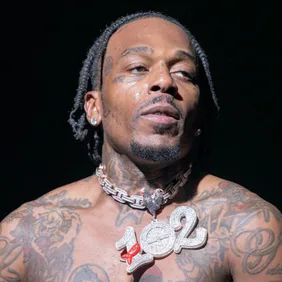When it was first announced that Mac Miller’s 2014 mixtape, Faces, would arrive on digital streaming platforms including Apple Music and Spotify on October 15, Miller fans rejoiced. Faces, Miller’s follow up to 2013’s Watching Movies With the Sound Off, had spent seven years swimming through rap’s underground, loved by diehards and mostly ignored by casual listeners.
Faces’ jump to DSPs changed all of that. Accompanied by the short film Making Faces and visualizers for each of the mixtapes 25 songs, Faces has become an anchor of nostalgia for some, and a window into an unknown version of Mac Miller for others.
Much like Making Faces, the mixtape’s initial rollout felt overwhelmingly positive and came with a somewhat whimsical tone. Amidst the filming of his MTV reality show, Mac Miller & the Most Dope Family, Miller appeared in front of his gaudy Los Angeles mansion and, with his dog under his arm, announced that Faces would drop on Mother’s Day, May 11, 2014.
The process by which listeners had to follow to download the tape only added to the humor.
Dale Berman/Getty Images
In order to download Faces, fans were tasked with making Miller a virtual sandwich. Once the bread, meats, and cheeses were out of the way, a download link was provided and it was finally time to hear what the then 22-year-old kid from Pittsburgh had to offer.
Those expecting anything resembling 2011’s Blue Slide Park or even the lighter moments on Watching Movies With the Sound Off, however, were sorely disappointed. Following its mixtape predecessor, 2012’s Macadelic, Faces starts with a somber note and holds it for the entirety of the project.
Rapping “I should’ve died already, came in I was high already, everybody trippin’ that my mind ain’t steady,” on the mixtape’s first line, Miller set the tone for what would prove to be one of the darkest and most introspective bodies of work he would release in his entire career. Where previous mixtapes like 2010’s K.I.D.S. was a watercolor painting of a wide-eyed, 18-year-old kid ready to take on the world and the rap game, Faces was a baroque masterpiece that told the story of a tortured 22-year-old who had reached the mountaintop and was devastated by everything he had seen along the way.
Before Faces, Miller carried the reputation of a white, frat rapper who had built everything on the back of a 2011 record referring to Donald Trump’s excessive wealth and his aspirations to take over the world. Riding the hype of “Donald Trump” into becoming the first independent rapper to debut at #1 on the Billboard Top 200 with his first studio album, Blue Slide Park, Miller’s upwards trajectory was undeniable. That is, until Pitchfork destroyed the album, likening Miller to Eminem at the 2000 VMAs, insinuating that he only had a fanbase because he was white, and ultimately giving the project a lowly 1.0/10 rating.
Miller bounced back, dropping Macadelic a year later with features from Kendrick Lamar, Juicy J, and Lil Wayne. Asking deeper questions and experimenting with new drugs, Macadelic saw Miller transform from the life of the party to a more reclusive figure who, in just 17 songs, changed his sound behind the scenes before fully returning with his second studio album, Watching Movies With the Sound Off.
Dropping Watching Movies on the same day as Kanye West’s Yeezus and J. Cole’s Born Sinner, Miller pushed the Pitchfork rating into a small, black box and delivered a legitimate hip-hop record, complete with features from Earl Sweatshirt, Schoolboy Q, Action Bronson, and Jay Electronica, as well as beats from legendary producers Flying Lotus and Alchemist.
During this time, Miller was filming Mac Miller & the Most Dope Family, but according to multiple radio interviews, Miller made the executive decision to ditch the TV show after two seasons to focus solely on music.
Enter, Faces.
According to Making Faces, Miller had transformed his pool-house into a studio and made it so that he could pretty much live there. Bringing in a series of instruments from pianos to guitars to cellos, Miller created a now-legendary studio space, referred to as the “Red Room,” for he, and seemingly-every LA-based artist coming up in the early 2010s to get to work.
This is where Faces was created. This is where the madness ensued.
Once tweeting “I was not on planet earth when I made Faces. Nowhere close,” Miller filled the then 24-song mixtape (“Yeah” was added as a bonus track when Faces hit DSPs) with references to his childhood friends, driving a BMW through the ‘hood and odes to his dead homies, but the constant three threads that drive Faces to a place of insanity are love, drugs and Miller’s place in hip-hop.
Unlike Miller’s 2016 release, The Divine Feminine, Faces is not explicitly about love but its presence on the project is undeniable. From the most obvious reference to the most powerful emotion, “Wedding,” which finds Mac loathing his girlfriend, and himself, for holding onto a relationship that’s already dead. Mix in lyrics like “I tell my b*tch if she don’t love me then just lie to me,” from “Diablo,” and “My b*tch hate me always tell me I should smile more,” from the Vince Staples-assisted “Rain” and we are faced with a picture of two people who, despite being in a relationship, are riddled with emotions bordering on hatred.
Miller never explicitly raps that he replaced love with drugs on Faces, but much like his love affair with lean on Macadelic, the mixtape is littered with substance references, some more obvious than others. The song “Angel Dust,” which finds Miller exploring the world of PCP, features a prohibitive message throughout the chorus.
“Don’t be scared, just come with me // Feels so good to feels this free // What are you afraid of? Tell me what you’re made of // What are you afraid of? It’s just a little angel dust”
From marijuana to liquor to the substance mentioned the most throughout Faces -- cocaine -- it’s clear that Miller was in the midst of heavy drug use (something he spoke at length about, both in interviews and his music) and was not hiding it. Rapping, “Everything will be so fine tomorrow, put the white away, we can do some lines tomorrow,” on “Malibu” and “Right nostril hasn’t worked in a week, plus the plug got work like he servin’ for a sheik,” on the Sweatshirt-assisted “New Faces V2” Miller made thinly-veiled references to cocaine and his affinity for the substance.
Like many who reside within the tortured artist archetype, however, Miller acknowledged the slippery slope he already found himself sliding down. Rapping, “A drug habit like Philip Hoffman will probably put me in a coffin, but down the slope in my toboggan,” on “What Do You Do” the Circles rapper knew exactly what fate he would face if his drug use continued.
On Faces’ closing track, “Grand Finale” Miller raps, “It’d be really nice to get to sit with Mickey Weiss, shoot the sh*t ‘bout life, he’d be pissed I’m sniffin’ white.”
Miller admits that Weiss, his late grandfather to whom he dedicated K.I.D.S.’ album cut “Poppy” would have been pissed to know he was doing cocaine, and in a way, despite the sense of artistic glory that comes with the drug use involved throughout Faces, it sounded like Miller was also pissed at himself.
On 2015’s GO:OD AM, Miller used the back half of “Perfect Circle/Godspeed” to dive into his drug use and the consequences it would lead to.
“White lines be numbing them dark times, the pills that I’m poppin’, I need to man up, admit it’s a problem, I need to wake up, before one morning I don’t wake up,” Miller rapped. “I’m speedin’ with a blindfold on, it won’t be long until they watchin’ me crash, and they don’t wanna see that. They don’t want me to OD and have to talk to my mother, tell her they coulda done more to help me and she’d just be cryin’ sayin’ that she’d do anything to have me back.”
That type of self-awareness, which Miller first began to explore Watching Movies and could no longer ignore on Faces, is what makes the mixtape arguably the most impactful body of work in his extensive discography.
To close his second verse on “Here We Go” Miller raps, “Tryna be a legend by tomorrow, they say I can’t I’m determined to prove ‘em wrong though, I’m not perfect but they ain’t either, I did it all without a Jay feature!” And that is the crux of the entire project. The same reason Miller decided to quit doing television is the same reason Faces sounds like it does.
Kevin Winter/Getty Images
Almost entirely produced by Miller himself under the alias Larry Fisherman, Faces is Mac’s most artistically-involved body of work and was a sort of ego death for everything that had come before it, and the blueprint for everything that came after.
GO:OD AM, released a year-and-a-half after Faces, took the ideas of “Grand Finale” and transformed the questions of a 22-year-old into an entire album pondering the meaning of a legacy and what it takes to leave a great one behind. The Divine Feminine took a conflicted lover and, with the help of Ariana Grande, followed Miller down a path of unabashed romance and explored every nook and cranny love has to offer.
And Swimming, a record largely based on the concept that “It is what it is,” eerily parallels Faces with more-heavily veiled references to substances, like on “Jet Fuel”, and the same types of questions about Miller’s place in hip-hop, and the world at large. On Swimming, however, Miller seems to have accepted his fate as an artist hurtling towards the sun, enjoying the simple things in life as he goes. Questions posed on Faces reappear on Swimming (and are answered on Miller’s posthumous Circles) but are asked in a way a 26-year-old Miller could, and a 22-year-old Miller could not. Where “Grand Finale” is brutally honest, Swimming’s closer “So It Goes” dances around the idea of death and provides a sense of clarity and acceptance that the life Miller lived was the life Miller chose.
Looking back on Faces with the knowledge that many of the predictions Miller made about his own mortality came to fruition only make the mixtape more poignant. When Miller died from an accidental drug overdose on September 7, 2018, the messages he intertwined throughout Faces took on an entirely different meaning. No longer were they the conjecture of an artist trying to find his way in the world. Instead, they were statements of fact — a foreshadow of the end.
While Faces painted a stark picture of what would eventually happen, the mixtape succeeded in transforming Miller from a cardigan-wearing teenager to one of the most musically-talented, philosophically-inclined and emotionally brilliant artists of his generation.







